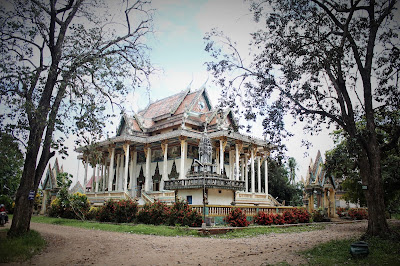After a fun couple of days which passed in a flurry of cheap
massages, $0.50 beers, good company, hangover breakfasts and satisfyingly cheap
noodle-eating, we said a sad goodbye to Siem Reap (as we have fallen in love
with that city), and headed off on the bus to Battambang, the second largest
city in Cambodia. Not one typically on the tourist trail, this is an old French
Colonial-style city with some lovely old French buildings in the centre,
nestled along the river bank, that have largely been camouflaged by garish shop
fronts and general disrepair and shabbiness. It has a decided charm to it though
(if you look hard enough), and we found ourselves actually quite liking it.
Our hostel was a good choice…a room for two, with ensuite
bathroom, overlooking the river for a puny $10 a night…and a lovely atmosphere,
good food, cheap beer (although this is a common theme in Cambodia), and a very
friendly tuktuk driver called DJ who took us everywhere.
Battambang is apparently the cultural capital of Cambodia,
and as such there are some lovely little art galleries, cafes and eateries
tucked away down ramshackle side streets, which makes them perhaps all the more
charming when you stumble across one.
At dawn and dusk the waterfront comes alive with people
doing their daily exercise. It actually has a really lovely vibe and we enjoyed
watching the middle-aged ladies doing keep-fit to tub-thumping Cambodian tunes
as the sun went down from our balcony. We less enjoyed getting woken up by the
same tub-thumping Cambodian tunes at 5.30am each morning.
I wouldn’t say there’s a huge amount to do here, but we
happily filled two days, and felt that was just about right.
On the first day we took a tuktuk tour of the nearbye sights with a lovely Irish girl from Gallway (also called Emma) who we’d met in our hostel. The tour took us first to the Bamboo Train. This is a train network set up after the Khmer Rouge regime was overturned in 1979 (more about the Khmer Rouge in future posts), and there was no money and no infrastructure. 600 miles or so of railway was built to help the people in the region travel more freely and transport goods where needed. Only a few sections are still in use, and many are so heavily mined still that they are inaccessible, but this little stretch is used to give tourists a ride. The railway consists of two very rickety tracks, and the ‘trains’ are basically a bamboo raft that sits on top of two sets of metal wheels which are turned by a generator (initially people would ‘punt’ the trains along with sticks before engines and fuel became available).
We were told the trip was a loop so imagine our horror when we’re trundling along at a rather impressive speed, and suddenly another train appears on the horizon ploughing headlong towards us!! Turns out this is standard and the solution is that you both have to stop and one train gets entirely dismantled to let the other pass, before being reloaded back on the track. Efficient. It was good fun though.
Bro being bossed around (you can't see me laughing!!)
The second stop was to a local Buddhist temple which was
used as a prison, torture chamber and mass grave during the Khmer Rouge regime.
Just behind the temple a statue has been erected to honour those who were
brutally killed here, and the skulls and bones of those found in the mass
graves next to the temple can be seen through the glass wall of the memorial.
The scripts on each of these sculptures on the base of the memorial paint a horrific picture of life under the Khmer Rouge rule.
This was perhaps made all the more poignant by the fact that DJ showed us round and told us that his mother and father had both spent four years working in the fields (peasants were typically expected to work from before dawn until nightfall in the extreme heat and humidity, with often only a few spoonfuls of rice to eat). It was incredibly humbling. As I’ve mentioned, more on the Khmer Rouge in future posts.
A monk just chilling (he hid his mobile when he heard me coming!...sneaky monk!)
Our next stop was a little lighter, and we got to see how
rice-paper (for spring rolls) is made, and got to enjoy some freshly made
spring rolls for 25 cents each!
Late afternoon we were taken to the tactfully named “Killing
Caves”. This, as you might have guessed, was used by the Khmer Rouge to murder
people, and then drop the bodies from the top of the cave, so that they
collected in a pile at the bottom. DJ spent the first 11 years of his life
living in a refugee camp in Thaliand, and remembers on returning to his
parent’s homeland in 1992, visiting the cave after school one day as he’d heard
rumours of what was inside, and was horrified to discover a huge pile of bones
and clothes where thousands of people had lost their lives. Can you imagine?
The bones have long been removed, but a shrine now exists for people to mark
their respects.

















No comments:
Post a Comment